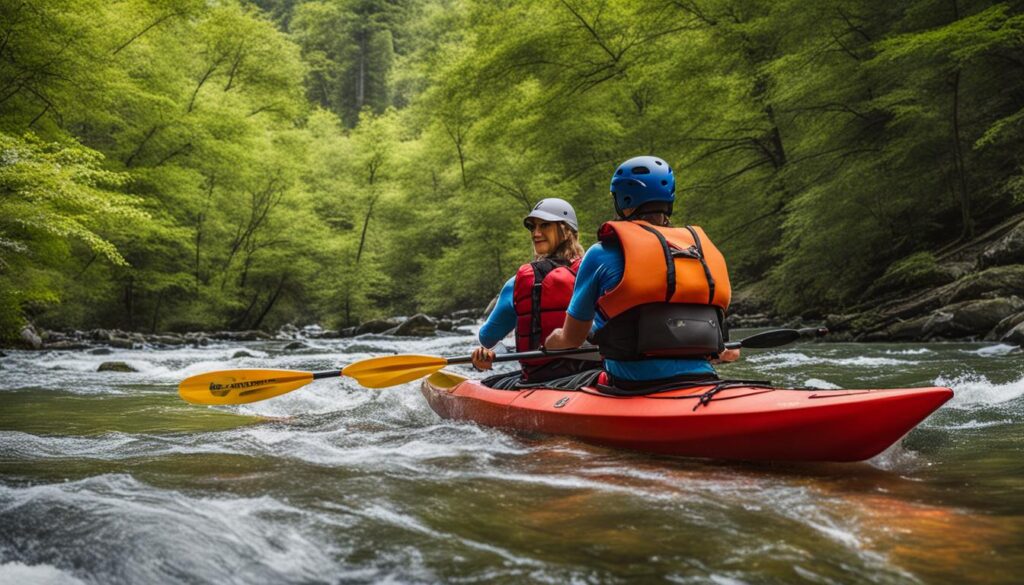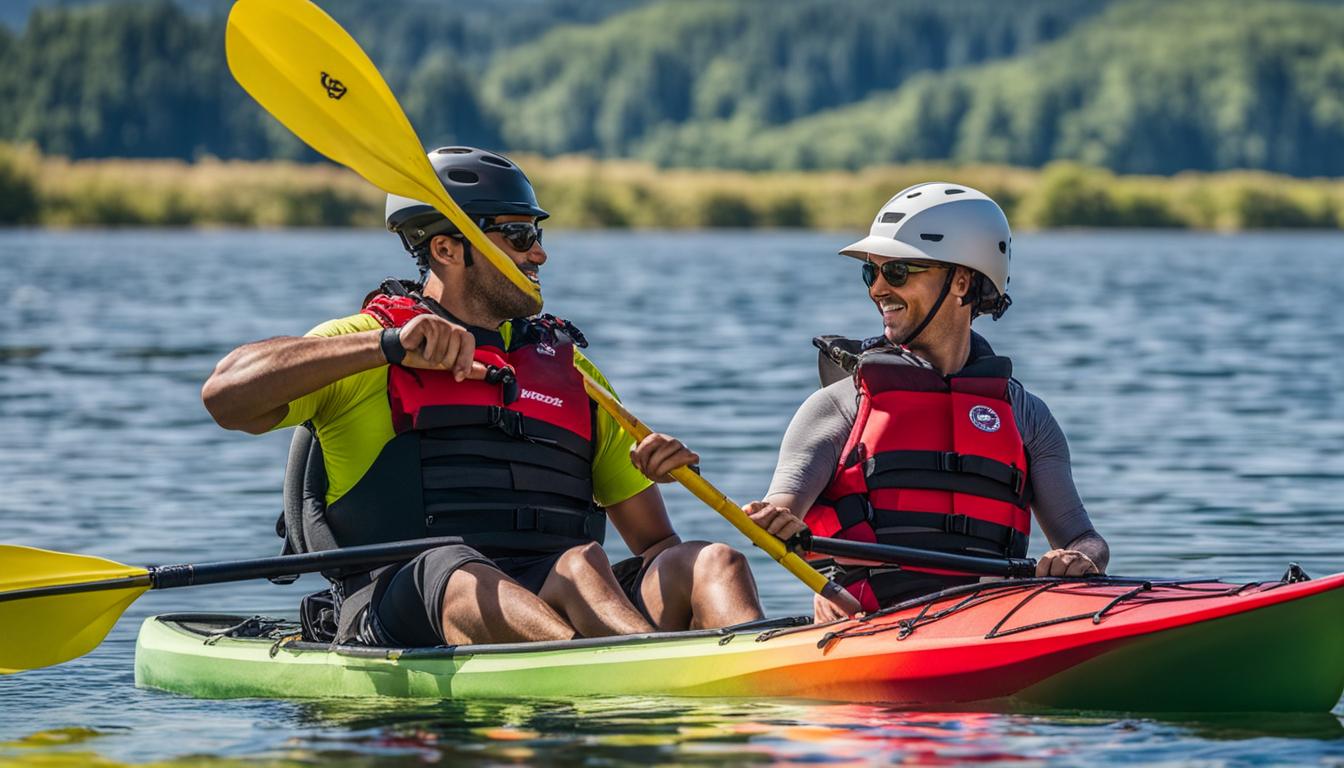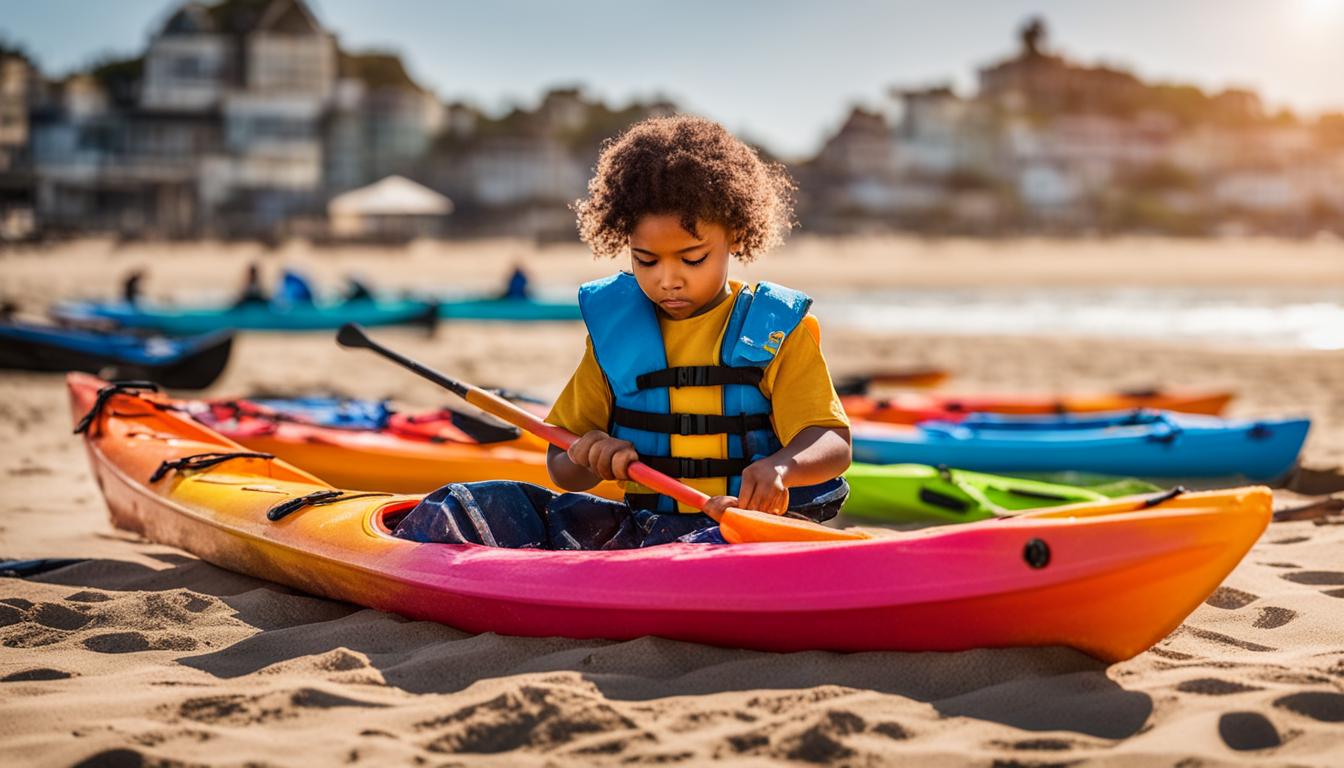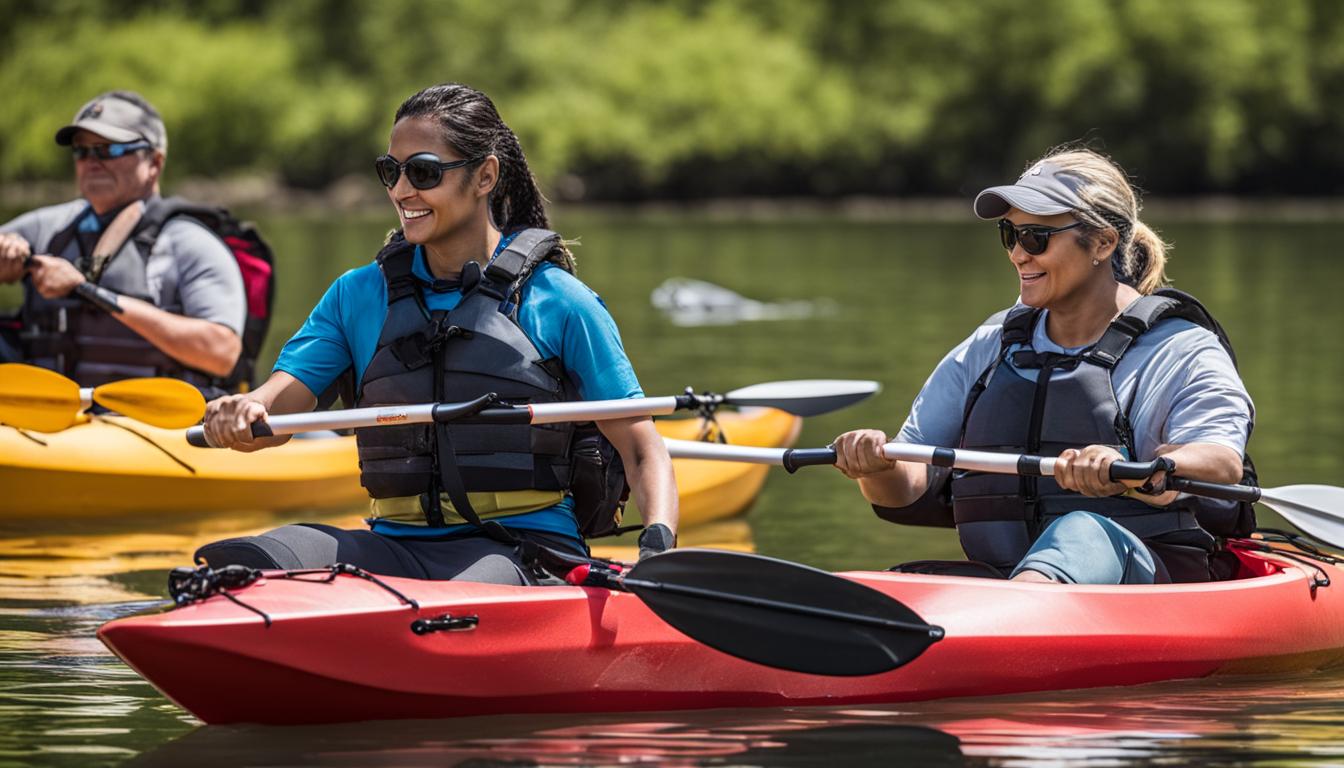Are you interested in teaching adaptive kayaking and providing individuals with special needs the opportunity to experience the thrill of kayaking? In this section, we will explore various techniques and strategies for teaching adaptive kayaking to diverse abilities.
Adaptive kayaking is a wonderful way for individuals with diverse abilities to enjoy the outdoors and connect with nature. With the right techniques and inclusive teaching strategies, you can create a safe and empowering water adventure for everyone.
Joe Mornini, Executive Director of Team River Runner, believes that kayaking’s appeal lies in its accessibility and the fact that it doesn’t require any special equipment to get started. Whether you’re teaching individuals with physical disabilities, visual impairments, or other special needs, there are adaptive techniques and methods that can be tailored to their unique abilities.
From specialized kayaking instruction techniques to inclusive teaching strategies, this section will provide you with valuable insights and tools to design adaptive kayaking courses and implement effective kayak instruction for all abilities. Let’s dive in and explore the world of teaching adaptive kayaking!
Key Takeaways:
- Teaching adaptive kayaking allows individuals with diverse abilities to enjoy the outdoors and experience the thrill of kayaking.
- Proper fitting of the kayak, launching techniques, and safety equipment are essential for a successful and safe adaptive kayaking session.
- Tandem kayaks can provide extra support and assistance for individuals with severe disabilities or visual impairments.
- Participating in the American Canoe Association’s Adaptive Paddling Workshop can enhance your knowledge and skills in teaching adaptive kayaking.
- Teaching adaptive kayaking not only provides physical exercise but also promotes emotional well-being and social interaction for individuals of all abilities.
Adaptive Kayaking Teaching Strategies
When it comes to teaching adaptive kayaking, it’s important to embrace inclusive instruction techniques that cater to individuals with disabilities. By adapting your teaching approach and employing specialized strategies, you can create a safe and empowering learning environment for all participants.
One of the key aspects of teaching adaptive kayaking is to prioritize safety. Ensure that participants are equipped with the necessary safety gear, such as personal flotation devices (PFDs) and helmets, to minimize risks. Additionally, focus on teaching fundamental skills that lay the foundation for a successful kayaking experience. This includes imparting knowledge on proper body positioning inside the kayak, techniques for stabilizing the kayak, and what to do in case of a roll-over.
Adapting teaching techniques and using specialized equipment can greatly enhance the experience for individuals with disabilities. Consider incorporating adaptive paddles, pontoons for added stability, and lateral/back supports to cater to specific needs. Moreover, providing hands-on teaching and individualized instruction ensures that each participant receives the attention and guidance they require for a successful kayaking journey.
Communication is key in adaptive kayaking instruction. Take the time to understand the unique needs and abilities of each participant, and make necessary adaptations to equipment, seating configurations, and teaching styles. By fostering a positive and empowering attitude, you can create a partnership with the participant, working together as a team to achieve their goals and provide a safe and supportive learning experience.

Key Strategies for Teaching Adaptive Kayaking:
- Create a safe and inclusive learning environment
- Teach fundamental skills and techniques
- Adapt teaching techniques and use specialized equipment
- Provide hands-on teaching and individualized instruction
- Consider the unique needs and abilities of each participant
- Choose suitable paddling venues
- Maintain open communication with participants
- Foster a positive and empowering attitude
- Continuously evaluate and adjust teaching strategies
Employing these adaptive teaching approaches will not only enhance the kayaking experience for individuals with disabilities but also promote inclusivity and empowerment on the water. By embracing these strategies, you can make a lasting impact and enable individuals of all abilities to enjoy the wonders of kayaking.
Conclusion
Teaching adaptive kayaking is an incredible opportunity to provide individuals with diverse abilities an empowering water adventure and connect them with the beauty of nature. By employing adaptive teaching techniques, instructors can create a safe and inclusive learning environment, adapting equipment as needed, and prioritizing the unique needs and goals of their participants.
Effective communication, patience, and a positive attitude are key elements in ensuring a successful and enjoyable experience for all. By attending the American Canoe Association’s Adaptive Paddling Workshop, instructors can enhance their teaching skills and gain knowledge about different disabilities and adaptive techniques.
Teaching adaptive kayaking enables individuals with disabilities to experience the joy and freedom of being on the water, benefiting from physical exercise, emotional well-being, and social interaction. It’s essential to celebrate the progress and achievements of each participant while respecting their individual challenges and limitations.
Through adaptive kayaking instruction, instructors play a pivotal role in promoting inclusivity, empowerment, and the numerous advantages of outdoor recreation for individuals of all abilities. Join the movement and help others discover the transformative power of inclusive kayaking instruction.
FAQ
What is adaptive kayaking?
Adaptive kayaking is a sport that allows individuals with diverse abilities to enjoy the outdoors and experience the thrill of kayaking. It involves making modifications to equipment, teaching techniques, and choosing suitable venues to ensure inclusivity and safety.
Why is kayaking a suitable activity for individuals with disabilities?
Kayaking is appealing to individuals with disabilities because it is accessible and doesn’t require any special equipment to get started. It offers a range of kayak types to suit different goals and conditions, such as recreational boats, inflatable kayaks, tandem kayaks, and sea kayaks.
What are some important considerations when fitting a kayak for adaptive kayakers?
Proper fitting of the kayak is crucial to ensure balance and control. Three points of contact should be maintained between the kayaker and the boat at all times. Modifications can be made to the boat and paddle to accommodate different disabilities, such as prosthetic sockets for lower limb amputees and special seating for those with spinal cord injuries or balance issues.
How should beginners launch into the water during adaptive kayaking?
Launching into the water should be done from a shoreline that is nearly level with the water, using a zero-entry launch technique. This technique is especially useful for beginners to enter and exit the kayak safely.
What safety equipment should be worn during adaptive kayaking?
Proper safety equipment, including personal flotation devices (PFDs) and helmets, should be worn during adaptive kayaking sessions. It is important to dress appropriately for the water temperature and consider using a dry bag for personal items while on the water.
How can experienced kayakers learn to teach adaptive kayaking?
Experienced kayakers interested in teaching adaptive kayaking can participate in the American Canoe Association’s (ACA) Adaptive Paddling Workshop. This workshop provides additional knowledge and skills specifically tailored to teaching adaptive kayaking.
What fundamental skills should be taught during adaptive kayaking instruction?
Fundamental skills that should be taught during adaptive kayaking instruction include proper body positioning inside the kayak, stabilizing the kayak, and what to do in case of a roll-over. These skills are essential for safety and enjoyment on the water.
How can teaching techniques be adapted for individuals with disabilities?
Teaching techniques can be adapted by using specialized equipment such as adaptive paddles, pontoons for added stability, and lateral/back supports. Individualized instruction and hands-on teaching are also important to ensure that each participant has a successful and enjoyable experience.
What should instructors consider when choosing a paddling venue for adaptive kayaking?
Instructors should choose a suitable paddling venue that is sheltered, free of hazards, and conducive to learning. For beginners, a swimming pool can be an ideal venue to introduce basic kayaking skills in a controlled environment.
How can instructors create a safe and inclusive learning environment for adaptive kayaking?
Instructors should maintain open communication with participants, ask questions to understand their comfort level, mobility issues, and any sensory sensitivities. They should foster a positive attitude and approach, emphasizing fun and empowerment while being mindful of participants’ limitations and boundaries.
How can teaching adaptive kayaking benefit individuals with disabilities?
Teaching adaptive kayaking allows individuals with disabilities to experience the joy and freedom of being on the water. It provides physical exercise, emotional well-being, and social interaction, promoting inclusivity, empowerment, and the benefits of outdoor recreation for individuals of all abilities.





